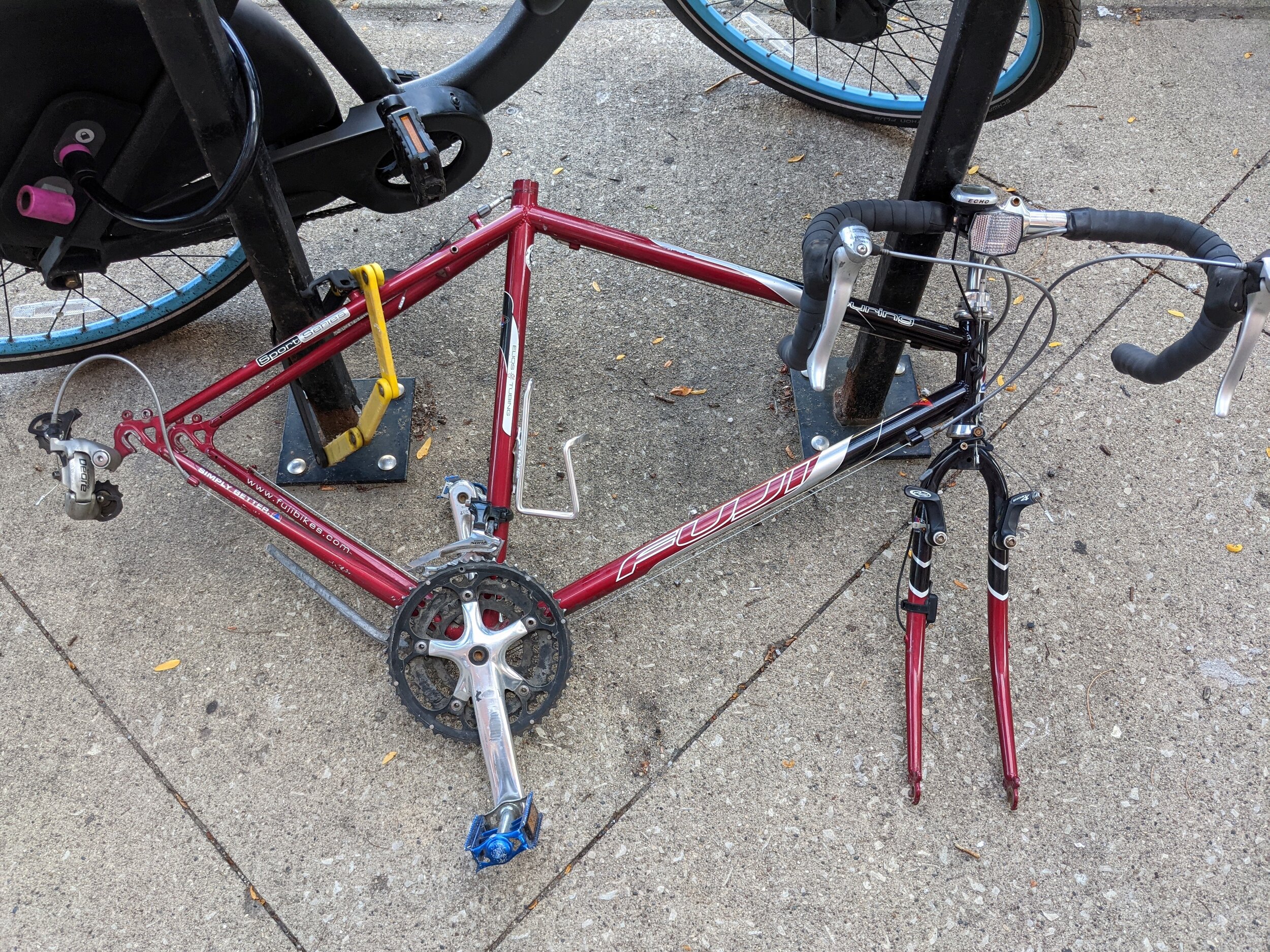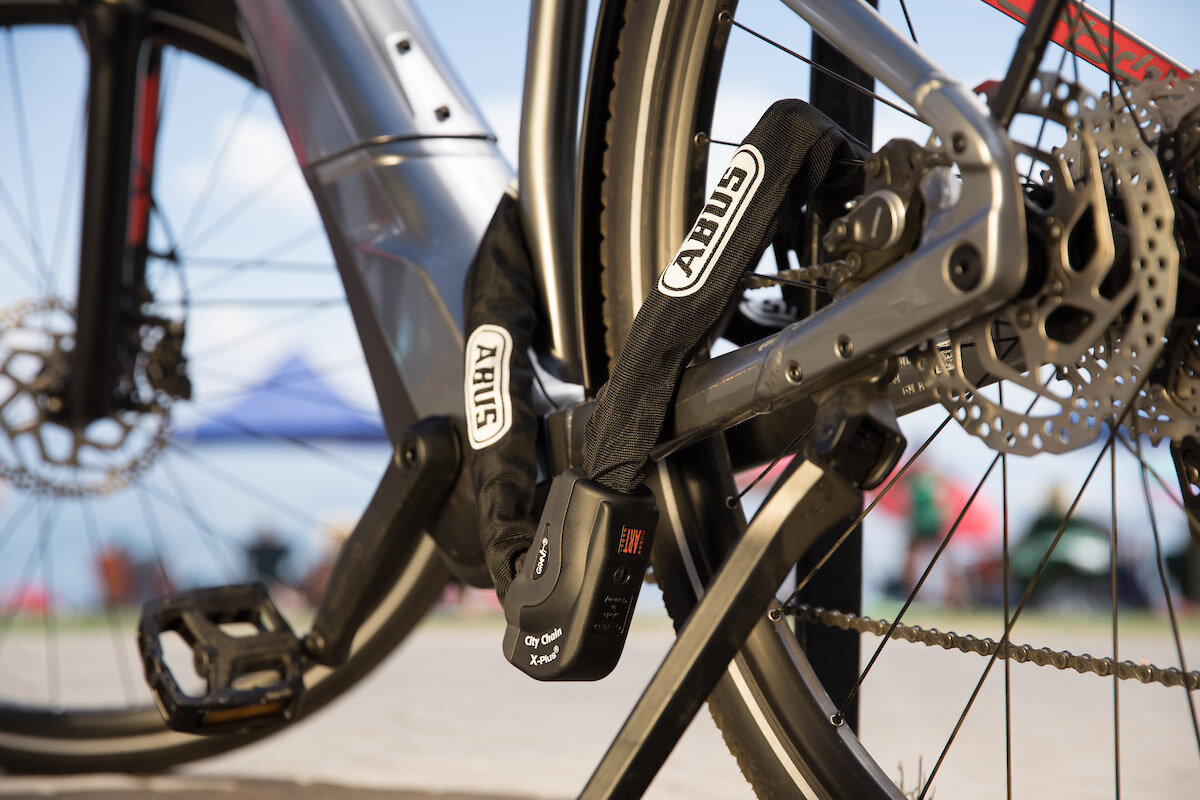The Completist’s Guide to Bike Security
September 21, 2021
*This essay contains Amazon affiliate links that benefit the author (though you should purchase from your local bike shop when you can). Prices will change.
Introduction
I care about your ability to get around and enjoy life in a way that is clean, healthy for the world around us, and without fear. And not just to remove the fear of having your bike stolen, but to fully embrace the memories and sentiment that your bike brings you. That’s why I wrote this essay.
There’s a lot of conceptual analysis here that’s likely to help you overall, but if you want to skip right to the goods, then you can go to the “Just Tell Me What To Do Already” section at the end. But consider reading the immediately preceding “How much should you spend?” section first. If you’re big into the details though, then you’re in for a treat. And as a heads up, this essay is rather US-centric; still, much of its information is relevant and adaptable wherever you live.
Ode to Bikes
It’s hard to understate how marvelous bikes are. They require less energy per mile than any other form of transportation (50x less energy than cars). Bikes take up way less space both during travel and for parking. This means less congestion and more opportunity for better uses of space in high-land-value areas. Bike infrastructure is enormously cheaper to create and even easier to maintain due to bikes’ low weight and smaller space requirements. Bikes (including e-bikes) are also quiet allowing for a better quality of life for those in urban areas—unlike combustible engine cars and trucks, electric cars at faster speeds, mopeds, and motorcycles, all of which cause terrible noise pollution.
Bikes also don’t emit carbon or other pollutants. Even with electric bikes, their efficiency makes their footprint minuscule relative to other transit options. Bikes are also really good at not killing people. The same can’t be said for cars. They’re responsible for killing other motorists by the tens of thousands each year in the US. Plus they take out innocent people on foot and bikes. That doesn’t even account for the indirect deaths that cars cause through air pollution.
Bikes are relatively cheap, too. You can get a solid brand new bike for around $500 or a really nice new bike for a couple thousand. That’s way cheaper than a decent used car. And even the nicest of e-bikes (e-bikes are amazing!) will be cheaper than the cheapest of new cars. Plus there are less expensive e-bikes in the $1-$2K range. Get any bike used and it’s even cheaper.
The maintenance on bikes is also far, far cheaper than cars—typical car maintenance runs around $1-$2K annually. Even a single surprise issue can take you back thousands of dollars. Not the case with bikes. All this means that poorer individuals can move freely and more well-off individuals can save money. Everyone wins.
Oh yeah, bikes are also great for your health in pretty much every way you can imagine.
Look at you, bikes. You deserve your own theme song. God damn!
And In The Other Corner
And wouldn’t you know it, some jerks want to ruin all that. And no, I’m not just talking about the terrible urban planners and politicians who refuse to create adequate bike infrastructure like protected lanes because it might inconvenience a few folks who insist on never leaving their cars.
I’m talking about those bastard bike thieves. These thieves steal our precious bikes. Then they sell it to someone else who can’t be bothered by asking questions about where the shady-looking bike came from. Bike thieves are successful for a number of other reasons. For one, police aren’t always eager to set aside time to go after bike thieves. (Perhaps it’s because they’re busy parking in the few shitty bike lanes we have while ticketing others for not riding in those same shitty lanes.)
According to one study, only one in 50 stolen bikes was ever recovered. Bike theft is a complex problem that requires a systemic solution (best video link in the whole essay right here). It’s also rampant. About one in 20 bike owners get their bike stolen. That’s a rate four times higher than those with cars and is likely far higher due to underreporting.
If we want everyone to feel more comfortable using their bike, then we have to address bike theft.
The Bike Thief’s Armory
A lot of bike thieves don’t screw around. The more sophisticated work in groups with heavy tools and even a vehicle to take your bike. But that kind of effort is often not necessary. Also, most bike thieves do not pick locks. Even a locksmith would find it simpler to just cut your lock. Unless you happen to have a particularly shitty lock that can be opened with lower-skill raking techniques, getting your lock cut is likely the way you’ll have your bike stolen. And even then, probably not. (Not to bash raking in the locksport community; I personally love rake attacks on locks.)
If you want to make a thief’s job easier, then just don’t lock your bike at all. Yes, some folks don’t lock their bikes. And while only about one in a hundred riders didn’t lock their bike at all, according to one study in Montreal, they were 8.5 times more likely to have their bike stolen compared to others who used some form of bike lock. Also, unlocked accessories, seats, and wheels can be stolen just as easily without any tools.
The most basic tools of a bike thief are wire or cable cutters. These are small, cheap, and easy to hide. They’re great for cutting cable locks. According to that same Montreal study, bikes using cable locks were stolen at a rate 25% higher than one would expect given their usage of just over a third of all locks.
Next up are bolt cutters. Bolt cutters can be bulkier, though some of them fold. Plus, in winter, they can be hidden beneath bulky clothing. Despite their size, thieves are not afraid to use bolt cutters in broad daylight. Bolt cutters work well against chain locks that are under 10 millimeters, which accounts for most chain locks. Above that, bolt cutters become less effective. That same Montreal study showed that those using chain locks were twice as likely relative to others to have their bike stolen. It’s unclear what size chains those who had their bike stolen used. Bolt cutters can also be used against lower-quality U-locks.
And finally, there’s the cordless angle grinder, the Master Sword of bike theft equipment (if Link were an asshole). These cost between $50 and $150. Due to their effectiveness, thieves can quickly get a clear return on investment. Whether you’re talking a thick chain or a U-lock, it’s only a matter of time before an angle grinder makes its way through a lock. The Montreal study did find that while most riders used U-locks, they were just 10% as likely relative to other riders to have their bike stolen. Even so, one out of 15 stolen bikes was secured with a U-lock.
The downside of angle grinders from a thief’s perspective is that they’re more dangerous to use (flying sparks and metal fragments). Of course, angle grinders are also more obvious. Strangely, that obviousness doesn’t seem to matter as much as bike owners would like, largely because angle grindgers are so quick. Only a minority of locks can last over a minute against an angle grinder. In fact, an angle grinder will defeat most locks in a fraction of that time.
You’ll notice that I’ll frequently reference this results table from this testing process described here quite a lot. This is the most thorough independent review I’ve found on the best and most popular bike locks using destructive attacks. Some of their testing regarding picking is questionable, but we can disregard that since we’re more concerned with destructive attacks. I’ve also independently verified their findings on multiple locks by comparing their outcomes with recorded attacks by others.
There are some other destructive attack tools that aren’t discussed here. I’ll leave them out because they’re either not very common (as far as I can tell), too specialized, or less effective than the other tools already listed. Regardless, the reality is that every lock has its kryptonite, especially when destructive attacks are an option. The key is to use layered security measures.
Integrating Layered Security
Layered Security
Layered security is a concept that simply means there is no single failure point within a system. For example, a thief couldn’t just clip a single lock and have your bike. You shouldn’t look at any one precaution and think if the thief only had this tool or planned in this one particular way. That’s not the point. The point is to overwhelm would-be thieves with barriers and do so in a way that the tradeoff is an acceptable inconvenience to you that doesn’t interfere with you wanting to ride your bike.
From the thief’s perspective, they’re thinking about relative value with their options. What’s the risk of stealing your bike compared to another one of equal or greater value? If your bike is of particularly high value, is the time cost or overall risk so high that it would be better to steal other bikes? That calculus may still not work out in your favor, so we’ll continue to explore further options.
Layered security is made up of multiple components. Those components can be:
Independent (requiring different tools or approaches to breach),
Sequential (a later layer doesn’t present itself until a previous layer is passed), or
Additive (the same tool or approach may be used, but multiple barriers within the layer require more time to be taken).
An example of independent components might be a heavy-duty U-lock alongside a frame/cafe lock. A heavier U-lock requires an angle grinder. A frame/cafe lock can technically be cut with an angle grinder, but sometimes the placement can make it tricky to cut it while avoiding damaging the bike. The bike thief could accept the damage or (more likely) opt to physically carry the bike and slow themselves down.
An example of sequential layers would be a lock and GPS device. The GPS device is only used if the thief surpasses the lock and physically relocates the bike.
Additive components would include using multiple locks. Most locks can be defeated with an angle grinder. But adding multiple locks means more time is required to cut them all and a greater likelihood that the thief will abandon their efforts.
These are the layers we’ll be covering, in order:
Location & visibility
Physical locks & deterrents
Notification & thief confrontation
Tracking & bike recovery
Covering losses (insurance)
Location & visibility
Interestingly, cheaper bikes are more likely to be stolen than more expensive ones (even when considering base rates). Aside from owners likely using better locks, locking location may also play a role. One way to deter thieves is to store the bike so it’s within eyesight. And if you can’t do that, store it in a secured area. Ideally, this is a place with cameras, additional secured doors, or an area that gets regular foot traffic.
Unfortunately, this isn’t foolproof. Brazen thieves regularly steal from homes, garages, locked facilities, and within crowded areas. We’ll talk more about this later. Still, the chances of your bike staying around are better in these areas than in a place where a thief has more privacy and room to work.
If all else fails and you’re going to an area that doesn’t have adequate bike protection and you don’t have the proper locks (discussed later), then you might also consider using a bikeshare for the trip. These are the pay-by-ride bike racks that you see in many cities. Once you dock or lock the bikeshare bike, the worry is out of your hands. Many bikeshares even offer e-bikes! Lyft, for example, connects you with bikeshares in many major cities so you don’t need a separate app.
Sure, the first time you try whatever phone app they use feels clumsy (I can attest), but it’s effortless after that. It’s also not too expensive—and way cheaper and more convenient than calling Uber or Lyft for a rideshare.
Physical locks & deterrents
This is what most folks think about when they think about bike security. A big ol’ lock. This is an important layer, so we’ll spend some time here.
Component locks
If you’ve seen locked bikes without a seat or with a missing wheel, then you’re reminded that there are jerks out there that will steal parts of your bike even if your frame is secure. (The image at the top of this article is from a picture I took just a few blocks from my home. Chicago is littered with stripped bikes.) Fortunately, there are some locks just for this situation.
There are multiple systems out there that require special tools other than an Allen wrench to remove accessories. This acts as a deterrent because it requires that the thief have yet more equipment. Another approach aside from requiring a special tool is to add gravity, which Abus ($25 Amazon) and Kryptonite ($30 Amazon) do. There are reports of these not functioning reliably when you want to take them off, however.
Right now, my preferred combination is using the Pinhead system ($90 Amazon) to secure the seat, wheels, front fork, and stem. This uses a uniquely “keyed” system to remove the bolts. The Hexlox system ($100) can take care of anything leftover that also takes screws. Also, everyone knows how to use quick-release systems. You should immediately replace them with the systems above if you plan to lock your bike in public.
Wheel immobilization locks
Frame/ cafe/ wheel lock
Don’t want your bike riding off into the sunset without you? Keep the wheels from turning with a frame lock. A frame lock affixes itself to the seatstay (look for the tube that goes down and away from your seat). It’s either screwed down with bolts if your bike is ready-made for it or you can use plastic ties. When it’s locked, a bolt goes in between the wheel spokes.
Other than just going at it with an angle grinder and potentially damaging the bike, a thief could also postpone cutting the frame lock until they move the bike to a more private location. Of course, this involves physically carrying the bike away, but that’s much harder than riding off with it (particularly with a heavy e-bike). A frame lock is mainly used to slow a thief down and make your bike inconvenient to steal.
A number of frame locks exist on the market. Abus carries them in a number of sizes ($40-50 Amazon). They also connect with an 8mm chain lock, though bolt cutters can handle these. Kryptonite ($40-$50) has some too with a slightly beefier 9mm chain option. (We’ll talk about chains more thoroughly in another section.)
Leo 2, ($269) is a frame lock that doubles with other layers such as tracking and notification. It also comes with a chain of up to 10mm ($42). This gives protection against bolt cutters while consolidating your own lock-up time by integrating the chain with the frame lock.
Abus is a solid choice for frame locks while the Leo 2 may be nice for protecting a more expensive bike. Also, don’t forget that you too need to remember to unlock the frame lock lest you pedal right through your wheel spokes.
2. Stem lock
A stem lock is a new approach that locks the handlebars on your bike so that they’re no longer perpendicular to your wheel. No one is riding your bike away, and an angle grinder won’t help any. They can, of course, still carry your bike.
The added benefit of this is that it also makes your bike easier to store by making the handlebars more compact to the bike and parallel to the bike frame and wheels. The main device here is n-lock ($135). It looks easy enough to install and works on a wide variety of bikes.
Now, there is some redundancy if you choose to have both a stem and frame lock. A frame lock immobilizes the back wheel (and secures it from detachment) while a stem lock just immobilizes the front wheel’s alignment so it can’t touch the ground and allow the bike to move forward. A thief could technically walk the bike (like a wheelbarrow) with one wheel down if the bike is secured with only one of the devices (frame or stem lock). But with both devices, the thief must physically lift both wheels off the ground (or walk very awkwardly).
3. Disc brake lock
While more common in motorcycles where there’s more space, you can also apply some disc locks to bicycles. This is another way to keep your wheels from turning, though it doesn’t keep the wheel from being removed. This may be overkill if you already have a frame lock, but it could be useful if your bike doesn’t support a frame lock. Indeed, the back wheel of some full-suspension bikes are incompatible with frame locks.
Kryptonite has a whole bunch of disc brake locks. Again, check to make sure it will fit your bike. There are lots of other options, too (some with fancy sensors integrating with other security layers). Also, like a frame lock, pedaling with a disc brake attached will screw up your bike. This is so common that there is a product that has a sole purpose to remind you to remove it.
Physical structures & proper locking
When you lock your bike, you’re generally locking it to something. So it’s best to be sure that you lock the right part of your bike to the right kind of structure.
You want to make sure you protect your frame, but also don’t forget your wheels—especially if they aren’t secured by other means. You can do both at the same time by inserting whichever lock you use between your wheel spokes and through the triangle formed by the three tubes in the back of your frame. You can do the same by going through your front wheel and your downtube when locking your bike to the solid fixture. But be sure to get your frame in there, too. When you see lonely bike wheels locked up, this is because the owner did not lock the frame. Particularly when using a U-lock, it’s better to apply the lock this way. It also gives the thief less slack and maneuverability to work with. That’ll make it even harder to cut.
When considering which fixture to lock to, think about whether the thief can remove the bike simply by lifting it up or by cutting the fixture itself with an angle grinder or bolt cutter. This also means checking things like whether a street sign or pole is actually connected with a bolt to its base. Some thieves deliberately remove the bolt and wait for someone to lock their bike to it only to lift the sign and steal the bike. These are called “sucker poles” and are depressingly more common than you might imagine. Other fixtures like fences can easily be cut, so don’t use those either. Traditional bike racks are obviously the best option if they’re available, though not all are created equal.
Don’t forget that you’ll still need a fixture to lock to even if you keep your bike in a garage or shed. People do steal from those too and way more frequently than you might think. Consider attaching your bike to a floor or wall anchor ($130 Amazon). Those aren’t going anywhere. Another route, depending on your space, is to get a traditional anchored bike rack ($170 Amazon). And do make sure whatever you use is anchored down—particularly if you’re getting bike insurance because your insurer may require anchoring to cover any claim you may have.
Of course, you’ll want to attach your bike to whatever you use with a heavy chain. Good minimum home chain examples are by Abus ($185 on Amazon) or Kryptonite ($150-$240). For home use, go for at least a 12-14+ mm (the thicker the better) chain using a lock with no worse cut resistance than the chain (that weakest link cliche was born from this very situation). These might work for multiple bikes if you want to make the most out of your chain. You can also find some super heavy chains at Lockitt. Consider getting a chain that interlinks to itself so that you can use an efficient roundlock ($70). If you go crazy and get a 22mm chain, then you’ll need this roundlock ($200).
Other options include a bike shed ($300-$600) if you have an outdoor area with a solid base (though some options give flexibility). Just lock the shed well, whatever kind of shed you have. Consider a strong closed-shackle padlock ($70 Amazon) or discus lock ($70 Amazon) to secure the shed if you go this route. These types of bodies will make it harder to access and cut the lock’s retracting bolt. For traditional sheds, also consider security hinge security pins ($10 Amazon) (for hinge attacks) and a security bar (Amazon $180). It’s also worth investing in a strong hasp, which is otherwise an easy line of attack. What you want to focus on here is the thickness of the plate (thicker the better) and the exposure of screws (you don’t want to give attack points). Also, be mindful that the space for the lock on the hasp (the staple) is large enough to fit the lock’s shackle.
If the place where you regularly store your bike for extended periods of time is a garage at work or another secured area, then you might consider leaving a super-heavy bike lock at that location. That’s where the Safe As Fuck (SAF) Altor lock ($300) weighing in at over 13 pounds comes in. This lock is intended to stay in one spot, though if you’re on an e-bike, carrying all that weight on occasion isn’t a dealbreaker.
Primary locks
Finally, the locks you’ve probably been thinking about all along! Primary locks (we’ll use this term to describe the main locks that attach your frame to a fixture) do a couple of tasks. One is they make it such a pain to steal your bike that the thieves look elsewhere. Secondly, they require time to get through—at least the good ones. This is the window where the thief can get caught either by (1) law enforcement or a bystander or (2) more likely, you. We’ll talk about notification layers in the next section where that time delay will come in handy.
What I won’t be recommending are cable locks. They’re terrible and are vulnerable to even the most poorly equipped thief who only has wire cutters. One exception to this may be to protect wheels and accessories, but the other measures to secure those components (discussed earlier) are better anyway and don’t add to the time it takes to lock your bike.
Chain Locks
Chains have the advantage of not being snippable by wire cutters. And once they get to be at least 10mm even bolt cutters have trouble clipping through without some serious effort. Chains are also more flexible than U-locks, so locking your bike to different objects can be easier. Some good portable chain locks also come in at a slightly lower price point than solid U-locks. The downside is that chains are bulky and can provide less angle-grinder resistance than some of the nicer U-locks.
The cheapest chain locks that are at least 10mm in thickness still typically cost near $100. These include the Kryptonite Evolution ($90 Amazon) (lock may be prone to weathering over time) and the Onguard Mastiff 8020 ($90 on Amazon). Both are well over five pounds of lock. The bad news is that these will still fall to an angle-grinder in under 30 seconds. The good news is that a thief is unlikely to get your bike without an angle grinder.
Unless the chain is staying in one place like your home garage, it doesn’t make much sense to go heavier or more expensive than this. Better instead to go with a U-lock.
It’s worth briefly noting that folding locks are also popular. They can be a little lighter weight and more compact. But even the bulkier ones are still vulnerable to bolt cutters. I don’t recommend these because at the price point of the nicer folding locks, you can get even better U-locks that are more resistant to angle grinders and don’t succumb to bolt cutters. There are, of course, many other bike lock styles that aren’t discussed, like the Liteloc that quickly fails to bolt cutters in the real world. The reason I don’t include other locks is the same rationale, which is that at the same price point there is a better security option (and this essay is already massive).
2. U-locks (AKA D-locks)
U-locks aren’t as maneuverable as other locks for securing your bike. But the better ones will at least add some good security. Many of these will also weigh in at around five pounds.
The OnGuard Brute ($65-$80 on Amazon) stands out as the best-value effective U-lock on the market, though it does have corrosion issues in wet climates. Others on the cheaper ($125-$170) yet effective U-lock end, are the Abus XPlus 540 ($145 on Amazon), Kryptonite New York ($170 on Amazon), and Kryptonite Fahgettaboudit ($135 on Amazon). These all require at least two minutes of angle grinder time and stand their ground to bolt cutters. This independently checks out on other videos. The Abus XPlus 540 holds its own against bolt cutters and lasts three and half minutes under the angle grinder. The Kryptonite Fahgettaboudit broke the blade right off a hydraulic bolt cutter (as did the OnGuard Brute).
On the higher end of U-locks, you have some options. First, there’s the Abus 59 Granite Extreme ($200-$250 on Amazon). This lock gives you plenty of locking space. It’s also been tested to last over six minutes against an angle grinder. If I were to recommend a lock that was in the sweet spot, it would be this one.
Another newer lock is by Hiplock. While I’m normally not impressed with some of their products, their D1000 series lock is quite impressive. It only has a small volume of space that it can lock. It’s big claim to fame is that it weighs only around five pounds yet holds up to an amazing 20 minutes against an angle grinder. As of this writing, it’s hard to find as it launched through a Kickstarter campaign. Its cost will probably be a few hundred dollars.
One innovative U-lock is the Skunk Lock ($180-$200 on Amazon). This lock isn’t designed to be particularly resistant to angle grinders compared to other high-end U-locks, but it does have a trick up its sleeve. The lock hits thieves with a noxious spray once its core has been penetrated. Though it’s hard to sympathize with a bike thief willing to use an angle grinder on your locks, it’s worth briefly considering the legal implications.
On the Skunk Lock’s FAQ page, their legal conclusion is that it is not an illegal “boobie trap” according to various state laws because it (1) is not concealed, (2) does not cause great bodily injury or death, and (3) does not have a trigger mechanism. If you actually did have a legal issue arise from your Skunk lock, it would likely be in the company’s best interest to make sure you win lest their entire business goes under. It also seems unlikely—though not impossible—that a thief would come forward since they would be confessing their own legal liability.
Finally, there’s that Safe As Fuck (SAF) Altor lock ($300) that was mentioned earlier. This lock is intended to stay in one spot, though if you’re on an e-bike, carrying all 13 pounds of its weight isn’t necessarily a dealbreaker, particularly if you’re only doing it for special situations.
There are the Altor videos testing the lock, but they obviously have a conflict of interest. According to one independent video attempt, however, it took six batteries, four blades, and over an hour and a half of grinding to get through the lock. That’s a helluva U-lock.
3. Carrying all those locks
So how do you actually lug all these heavy locks around when you’re riding? You don’t want them moving around, and you don’t want them throwing off your center of gravity.
For U-locks, some locks come with a special bracket that attaches to your frame. If your experience with many of these is anything like mine, they suck. Your knees just bounce the lock back and forth while you can never seem to tighten it down just right.
The better U-lock holders have more than one point of contact with the lock and frame to avoid this irritating swinging action. The Huldit U-lock holder ($30) attaches to your top and either your downtube or seat tube. Depending on your frame, you could hold up to two U-locks this way.
With LockRockIt ($40), you can attach a holder to the top of your seatpost. The U-lock sits horizontally, but the make of the holder material seems to keep it reasonably in place. You can also hold multiple U-locks by intersecting a second U-lock through the top. It seems to work well enough without too much jostling. This seatpost location also frees up space for other items on your frame.
Chains can be more or less versatile at the same time. Some people wear their bike chain across their body like a sach (think beauty pageant winner). That’s a bit less freeing for some and can be uncomfortable. Others may tightly wind the chain around their seatpost, but that can scratch up your bike.
There are bags that fit within your frame ($15 on Amazon) that you can use to hold your chain. This is probably the best solution to carrying a chain without getting too expensive. You can even fit other stuff in there too. Be mindful that it will fill a lot of space on your top and down tubes.
Probably the easiest solution to carrying locks is if your bike has a rack. If it does, just use a short bungee cord ($5 on Amazon) to attach it. Or, you can toss the locks in your basket or one of your pannier carriers.
Notification & thief confrontation
While there are more layers beyond this one, this is the last one before the thief has actually stolen your bike. This is also where you get to leverage all that money you spent on making the thief take longer to get through your locks.
This notification section is based on either you randomly getting back in time or using a notification device. These notification devices use an accelerometer to let you know when someone is messing with your bike. These all work under the same idea. When the device senses your bike is being tampered with (jostling is enough), it then notifies you on your phone. Some of them also sound an audible alarm. Many of these have GPS trackers built in too, which we’ll talk about later. These typically require purchasing a separate data plan for $3-$5 a month, though they often give you the first year or so for free.
Here are a couple of your options. The newer Leo 2 frame lock ($269) mentioned earlier has this notification functionality built in. Boomerang ($125-$150) is another device that texts you when it senses it’s getting messed with. Boomerang uses special screws to attach to your bike frame (which also means you lose space on your bike frame). Remote notification is a newer area where we’re sure to see some new developments, but these are two of the top devices.
So say you get a text on your phone notifying you that someone is attempting to steal your precious bike. You take a look, and sure enough, there’s some jackass trying to jack your bike. What do you do now?
If you call the police, it’s unlikely that your bike will still be there by the time they arrive. Unless you’re willing to track down your bike after the fact instead, confronting them yourself is the only option here. A simple, “Hey, get away from my bike. I’m calling the police right now. ” is probably going to send a good number of bike thieves running. Recording them on your phone while you say this can also incentivize them to flee.
If you cannot scare the thief away, then you can technically use force if that’s something you’re comfortable with. This is where the use of reasonable force and defense of property comes into play (laws on this vary by state). The more restrictive state laws require that you first request the thief to stop before engaging them physically. Pepper spray is a solid tool here if you need that next step. Pepper spray will give anyone a terrible day. Its effects are typically quick and fully recoverable, which is exactly what you want.
I recommend this version of Sabre Red because it won’t accidentally go off in your pocket. It has up to 25 brief sprays that go up to 10 feet. That range and flexibility are helpful for when the thief has an angle grinder and wants to use it as a weapon. The manufacturer recommends an ear-to-ear spraying motion. I’d also recommend getting a practice container first, which will let you try shooting a couple of sprays of water so that you get a feel for it. As a heads up, pepper spray composition laws can vary by state, so make sure you get a pepper spray that’s legal where you are if you want this option.
Keep in mind that if this interaction with the bike thief does become physical, then you still have to keep your wits about you. This means you must limit yourself to using proportionate force for the situation, and you can’t do anything that would cause the thief great bodily harm or kill them just to protect your property. Also, if the thief is subdued and no longer a threat to you or your bike, then you can’t keep attacking them. If you keep attacking them beyond this point, then you’re the aggressor, and you could face liability.
If your jiu-jitsu skills are up to the task, then you can detain the thief with a citizen’s arrest long enough for police to come. This comes with clear risk to most people, of course, so use good judgment. And be careful not to contaminate yourself with your own pepper spray.
Tracing & Bike Recovery
You come back to where your bike was parked. Aaannd ... it’s gone. Son of a bitch! Well, I hope you remembered to do all the things in this section beforehand. If not, we’ll do what we can.
Let’s say that you manage to track down your bike or someone else spots it. How would they know it’s stolen, and how could you prove it was yours? Let’s make sure you’re ready for that moment.
You need to register your bike at bikeindex.org ($0). Just do that now, and maybe throw them a donation while you’re there. You can do this before or after your bike is stolen, but before is way better. This is the largest US national registry for bikes and will make recovering your bike way easier and more likely. If you’re outside the US, look for your local registry.
You should upload a picture of yourself with your bike, and put all the details about your bike there, including the serial number. It’s possible that a thief may scrape away the serial number on your bike. Fortunately, you can also write it down elsewhere on your bike with an invisible UV marker ($9 on Amazon). You could technically mark your bike with your address or other identifying information, but there are also risks from letting the thief know where you live. Also, anyone who really cares about getting your bike to you will check your serial number against the bikeindex.org registry.
So let’s say you’ve done all that and you see that your bike is stolen. You should now take pictures of your broken lock (if there’s anything left) and where you parked. You’ll want to file a police report. You can do that by dialing your local non-emergency number. No one will get mad if you dial 911, but it’s better to keep that line open for others (unless you are actively tracking your stolen bike). You’ll provide your name and a description of your bike, including the serial number. You can note that your bike is on bikeindex.org as well and give them your profile. If you have a GPS device on your bike, let them know now and tell them how accurate it is and what its whereabouts are.
Enter GPS Tracking
To track your bike, you’ll need to have attached a GPS device (and an included SIM card with a ~$3/month fee after the first year or so). You would think most e-bikes would come with these installed already given their expense and built-in power source, but you’d be wrong. Generally, you have to get these after purchase.
We’ve discussed two of these devices already, Leo2 frame lock ($269) and Boomerang ($125-$150). Another device is Sherlock ($150), which fits in your handlebar. Sherlock’s tracker doesn’t have the same accelerometer as the other two do, but it does provide a sharable code that you can give to the police so they can track your bike. There are other trackers out there as well, but these are currently the most useful and popular. Bike companies really just need to start building trackers into the bikes or designing bikes with trackers in mind.
Both the Boomerang and the Sherlock devices have battery lives of 4 weeks and two weeks, respectively. Boomerang’s battery depletes quickly after it’s in “stolen” mode and will last up to 8 hours with a full battery, but it gives frequent notifications. Sherlock has a setting to make it last up to four days by having it ping the device every couple of hours. It can also ping at shorter intervals, but this will shorten the battery life to 10 hours at most. Leo 2 claims to have a battery life of up to 5 months and does not give specific details of battery life expectations during different modes or ping rates (I asked them as well and they gave me a vague answer). All the devices mentioned here are charged by USB.
There’s also the option of an AirTag, which is exclusively compatible with Apple products ($30 on Amazon). You can stick these to your bike, such as under the seat. Airtag has a better reputation and some of the other tag-based cheap tracking solutions don’t quite seem to be there yet as far as I can tell by reviews.
If you’re tracking your bike and the police aren’t willing to help you retrieve it, then you could retrieve it yourself. This comes with obvious risks, including accidentally breaking other laws such as trespassing. Practically speaking, it’s still best to be as helpful as possible to the police to try to make their jobs easy. This will increase the likelihood that they’ll help (more on that shortly).
No GPS tracking?
If you don’t have GPS tracking, then it’s time to first mark your bike on bikeindex.org as stolen and make sure you file your police report. Following that, you’ll want to set up immediate Google Alerts and look at the following sites where stolen bikes are often listed:
Local markets and pawnshops
Identification & Recovery
You’ve done all the steps and you see your bike. What next?
In an optimal scenario, you see your bike abandoned. If you can absolutely verify the bike is yours and it looks abandoned, then you’ve got your bike back. Congrats!
If you have to arrange to meet the thief after finding your bike listed, then you’ll have to take more precautionary measures.
Step 1: Don’t use your real name or contact information. You’ll likely have to contact the thief or person who purchased your stolen bike. When you do this, don’t use your real name, and don’t use your real contact information. You can get a burner/throwaway number with a smartphone. Use that. And I’m pretty sure that every Yahoo, AOL, or Hotmail email is pretty much worthless anyway, so create one of those for your email.
Step 2. Make sure the bike is actually yours: Lots of bikes look alike. You don’t want to infuriate someone who’s honestly trying to sell their own bike, and you don’t want to waste the police’s time. Look for clear clues and details about your bike such as customizations, unique markings, and the serial number. You may also request extra pictures from the seller as well.
Step 3. Inform the police: If you’ve confirmed the bike is yours and you’re arranging to meet the person, then you need to let the police know. Make sure you’ve already filed a report. Try to make the meeting close to a police station so they don’t have to travel far. If you are organized with your information, then the chances are better that they’ll help. You should also have a friend not too far away and let others know what you’re doing. It’s also possible that the police will intercept the person so that you don’t have to engage with them in person.
Does this actually work? It has for some people at least. One zealous Seattleite, nicknamed Bike Batman, has even made a hobby out of recovering other people’s bikes. You can also find stories of how others have worked with police to reclaim their bikes. As a cautionary note, while it’s not always necessary to confront a thief in person, there is, of course, risk when you do.
It’s also possible that the person with your bike didn’t actually steal it. It could have already exchanged hands, which can happen rapidly. That said, while the state laws vary on the details, it’s still a crime to knowingly receive stolen property. In some states (like Ohio), if you didn’t know but you should have known the property was stolen, then it’s still a crime. Matters get worse when the person crosses state lines. Let this also be a lesson to not purchase sketchy goods.
You may be wondering to yourself what bike recovery looks like in practice. Here are a range of answers:
Bike owner in Washington (Spotted online, recovered with police)
Bike owner in DC (Spotted online, recovered without police)
European Bike Theft (Spotted with AirTag, recovered without police)
US Bike theft (spotted by eye and recovered with police)
Nebraska Bike theft (Spotted by pawnshop tracking registry system, recovered with police)
Colorado Bike Theft (Spotted online, recovered without police when police refused)
Oregon Bike Theft (Spotted online, recovered with police)
Insurance: accepting the loss
What if you’ve taken all these steps and you still can’t get your bike back? If you have insurance, then you can at least recover some of your financial loss and replace your bike. Let’s look at your options.
Homeowner’s and renter’s insurance are almost universally inadequate for bike insurance. It’s better to go with a specialist insurance company. The company for bicycle insurance is Velosurance, though be mindful that they do not cover bikes purchased for under $500.
Policies will run around $100-$600 annually ($8-$50/month) per bike, depending on the bike’s price tag and coverage. The policy can also cover much more than just theft, which can come in handy. This includes perks like crash damage, replacement bike rental, medical, personal liability, and roadside assistance. But be careful about the policy details. They’re particular about how your bike is locked, including when it’s at home. Your bike has to be locked to an object that is immovable and affixed to stone or concrete if you want to collect on a theft claim. While policies will vary, here’s a sample of what some of the details look like.
If your bike is stolen, Velosurance will ask for specific information. So be prepared to collect this information along the way:
A police report detailing how the theft occurred; submit your claim ASAP, even if a police report is not immediately available
A picture of the defeated security device/lock, if available
Your statement of how the bike was secured
A receipt or photo of the security device, if available
Be sure that you’re doing all the steps required by your policy within the proper time frame. The last thing you want is to have paid for insurance only to not be able to get them to pay out on a claim due to a technicality.
Insurance lets you guard against catastrophic loss by paying a premium along the way. Technically, it’s not cost-effective for you. But insurance can limit disruptions to your finances and means of transportation. And that peace of mind could get you out there riding more, which is what we want to see.
How much should I really spend on bike security?
This is worth pondering over because you’re not just thinking about the cost of your bike. Consider everything else that has a cost:
The emotional toll a bike theft will take on you (we know it’s real)
Getting stranded somewhere and figuring out how to get back
The financial replacement cost for not just the bike but all its customizations
Your time sink for the police report, filling out the necessary paperwork, and replacing your bike with all its customizations
The time that you’ll be without a bike until you replace it
The risk that you’ll bike less if you’re too worried about your bike getting stolen
So when we think about how much to spend, we’ll also want to consider the base cost for your time and mental anguish—not just the direct financial cost of the bike. Don’t forget either that a theft-prevention device can typically be reused for a later bike. Your locks aren’t just for the lifecycle of the bike you’re using now. And if you upgrade your bikes later, then you can always sell your older locks.
But yes, we’ll still consider the cost of the bike and all its components when thinking about how much to spend. That said, the recommended spending floor may be a little higher than you’re initially thinking. Remember as well that cheaper bikes under $500 are actually more likely to be stolen (1.25 times higher than their base rate). This may be because they’re more likely to be locked insecurely.
What you’ll find in practice, paradoxically, is that as the cost of the bike increases, the lower the percentage of the cost you wind up spending on security. There’s a floor cost for basic security that has to be accounted for, which isn’t negligible. Good locks aren’t cheap, and we’re not here to waste time or money replacing cut locks.
This is what we see in practice:
Total bike Cost | Security cost as bike value percentage
Inexpensive (<$500) | 40-100%
Average ($500-$2,500) | 30-70%
High-end ($2,500-$5,000) | 25-40%
Premium ($5,000-$13,000+) | 20-35%
This may come as a sticker shock to some, and the next section on recommendations may as well. But it’s really worth considering paying more upfront on security—especially for those who use a bike as their primary means of transportation. And consider your savings compared to a car. Compared to a bike, a car is far worse on price in a number of categories:
Upfront purchase price
Maintenance
Fuel
Traffic tickets
Insurance
Those aren’t trivial costs, and those are costs that are comparatively mild for bike owners. Giving back a little bit of those savings so that you can fully utilize your bike makes it worth it.
Of course, you can always go lower than what’s recommended in the next section, but the tradeoff is that you increase your risk.
Just Tell Me What To Do Already
Total Bike Cost: <$500
Storage Location:
Recommended:
Chained to a secure object with your regular primary lock, preferably in a secure enclosure.
Accessory/Wheel Locks:
Recommended:
Abus ($40 on Amazon) or Kryptonite (Amazon) ($40-$50) frame lock OR cable lock (any; cable locks don’t stand up to wire cutters anyway, and you’re just using it to make your wheels harder to steal)
Optional:
Pinhead system ($90 Amazon) OR Hexlock system ($100) [In place of a cable lock]
Abus 8mm chain lock plug-in for frame lock OR Kryptonite 9mm chain plug-in for frame lock ($40-$50). [Can replace a locking mechanism for the back wheel]
Primary Lock:
Recommended:
Chain lock: Onguard Mastiff 8020 ($90 on Amazon) OR Kryptonite Evolution ($90 Amazon)
OR U-lock: OnGuard Brute ($65-$80 on Amazon)
Optional:
U-lock: Abus XPlus 540 ($145 on Amazon), Kryptonite New York ($170 on Amazon), and Kryptonite Fahgettaboudit ($135 on Amazon) OR OnGuard Brute ($65-$80 on Amazon)
Tracking:
Recommended:
Bikeindex.org Registration ($0)
AirTag (Apple device compatible only) ($30 on Amazon)
Invisible UV marker ($9 on Amazon)
Insurance:
Recommended:
None
Total Security Cost:
$175-$480
Total Bike Cost: $500-$2,500
Storage Location:
Recommended:
Chained to a secure object with your regular primary lock, preferably in a secure enclosure.
Optional: Floor or wall anchor ($130 Amazon) with Abus ($185 on Amazon) or Kryptonite chain ($200-$240).
Accessory/Wheel Locks:
Recommended:
Abus (Amazon) or Kryptonite (Amazon) ($40-$50) frame lock
Pinhead system ($90 Amazon) OR Hexlock system ($100)
Optional:
Abus 8mm chain lock plug-in for frame lock OR Kryptonite 9mm chain plug-in for frame lock ($40-$50).
n-lock ($135)
Primary Lock:
Recommended:
U-lock: Abus XPlus 540 ($145 on Amazon), Kryptonite New York ($170 on Amazon), and Kryptonite Fahgettaboudit ($135 on Amazon) OR OnGuard Brute ($65-$80 on Amazon)
Optional:
2nd U-lock: Abus 59 Granite Extreme ($200-$250 on Amazon) OR Skunk Lock ($180-$200 on Amazon).
Tracking:
Recommended:
Bikeindex.org Registration ($0)
AirTag (Apple device compatible only) ($30 on Amazon)
Invisible UV marker ($9 on Amazon)
Optional:
Linka frame lock ($269) OR Boomerang ($125-$150) OR Sherlock ($150)
Pepper Spray ($12)
Insurance:
Optional:
Velosurance ($100-$200/year)
Total Security Cost:
$325-$1,000
Total Bike Cost: $2,500-$5,000
Storage Location:
Recommended:
Floor or wall anchor ($130 Amazon) with Abus ($185 on Amazon) or Kryptonite chain ($200-$240). Or traditional bike rack ($170 on Amazon).
Optional:
Bike shed or other enclosure ($300-$600) with closed-shackle padlock ($70 Amazon) or discus lock ($70 Amazon)
Safe As Fuck (SAF) Altor lock ($300) for long-term daytime or nightime storage with rack
Accessory/Wheel Locks:
Recommended:
Abus ($40 on Amazon) or Kryptonite ($40 on Amazon) ($40-$50) frame lock
Pinhead system ($90 on Amazon) OR Hexlock system ($100)
n-lock ($135)
Optional:
Abus 8mm chain lock plug-in for frame lock OR Kryptonite 9mm chain plug-in for frame lock ($40-$50).
Primary Lock:
Recommended:
U-lock: Abus 59 Granite Extreme ($200-$250 on Amazon) OR Skunk Lock ($180-$200 on Amazon).
Optional:
2nd U-lock: Abus XPlus 540 ($145 on Amazon), Kryptonite New York ($170 on Amazon), and Kryptonite Fahgettaboudit ($135 on Amazon) OR OnGuard Brute ($65-$80 on Amazon)
Tracking:
Recommended:
Bikeindex.org Registration ($0)
Invisible UV marker ($9 on Amazon)
Pepper Spray ($12)
Linka frame lock ($269) OR Boomerang ($125-$150) OR Sherlock ($150)
Insurance:
Velosurance ($200-$300/year)
Total Security Cost:
$1,000-$1,500
Total Bike Cost: >$5,000
Storage Location:
Recommended:
Floor or wall anchor ($130 Amazon) with Abus ($185 on Amazon) or Kryptonite chain ($200-$240). Or traditional bike rack ($170 on Amazon).
Safe As Fuck (SAF) Altor lock ($300) for long-term daytime or nighttime storage with rack
Optional:
Bike shed or other enclosure ($300-$600) with closed-shackle padlock ($70 Amazon) or discus lock ($70 Amazon)
Accessory/Wheel Locks:
Recommended:
Abus ($40 on Amazon) or Kryptonite ($40 on Amazon) frame lock
Pinhead system ($90 Amazon) OR Hexlock system ($100)
n-lock ($135)
Optional:
Abus 8mm chain lock plug-in for frame lock OR Kryptonite 9mm chain plug-in for frame lock ($40-$50).
Primary Lock:
Recommended:
2x U-lock: Abus 59 Granite Extreme ($200-$250 on Amazon) OR Skunk Lock ($180-$200 on Amazon).
Tracking:
Recommended:
Bikeindex.org Registration ($0)
Invisible UV marker ($9 on Amazon)
Pepper Spray ($12)
Linka frame lock ($269) OR Boomerang ($125-$150) OR Sherlock ($150)
Insurance:
Velosurance ($300-$600/year)
Total Security Cost:
$1,850-$2,500
Happy Cycling!
While we can’t guarantee against bike theft, we can significantly reduce the odds along with increasing the chances of recovery. And that frees us up to focus our excitement on actually riding and enjoying our bikes. Happy cycling!
And as a thank you for reading through this long-ass essay (or skipping to the the part you wanted), here’s one of those strangely satisfying restoration videos. But with a bike!






































